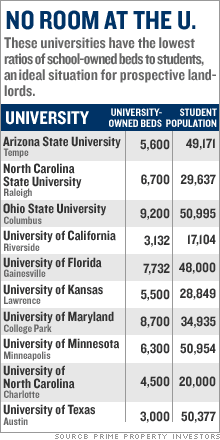Own where the kids are If you want to become a landlord, it's time to go back to college - where housing demand is booming along with admissions.
(Business 2.0 Magazine) -- One of the many oddities of real estate investing is that the best time to plunge in is usually just when things are starting to go south - meaning now. While momentum is starting to carry the market down, home prices are still out of range for a lot of would-be buyers, which helps to buoy rents. Further burgeoning the tenant ranks are the thousands of homeowners selling now in the face of rising interest rates. According to the National Association of Realtors, rents nationwide are expected to jump an average of 5 percent by year's end.
This explains why investment pros have begun pouring money into all kinds of rental markets. One of the hottest now is student housing. Fewer rooms, rising admissions Michael Zaransky, co-founder of Prime Property Investors in Chicago, began investing in student housing three years ago when, he says, "we noticed that prices of apartment buildings in college towns were stronger compared with other cities and still trading hands at substantial profits." Zaransky turned up several reasons that college-town apartment buildings are a smart bet. First, inventory is shrinking: Public universities have suffered from continual belt-tightening in recent years, leaving most without money to upgrade or build out dorms and other housing units. Second, demand is skyrocketing: Colleges are starting to see a surge in admissions, especially from so-called echo boomers, the children of baby boomers. For investors, that adds up to remarkably low vacancy rates near campuses. Prime Property owns 21 apartment buildings in five college towns in Florida and the Midwest, and Zaransky says "we are 100 percent occupied" - even during summer months. That's significant, considering the industry average of 90 percent for commercial apartment buildings. Prime Property also got remarkable rent increases in 2006, as high as 13 percent at its eight buildings near Purdue University in Indiana. Do your homework To pick the best towns, Zaransky offers investors a handful of market-research tips. First, check the supply: Find out how much of the available housing is university-owned. Next determine the ratio of university-owned beds to students. Zaransky prefers a ratio of 30 percent or lower. Last, he says, look at projected enrollment growth for the next 10 years, favoring schools expanding their student ranks by at least 2 or 3 percent a year. A word of caution, however, before you start prospecting houses or apartment buildings for your college-bound son or daughter. As Ralph Block, a real estate strategist at Phocas Financial, notes, it's a high-priced game in which most investors pool their money with others through private partnerships, with a typical minimum of $100,000. Being a college-town landlord comes with a unique set of headaches too. "This business is very management-intensive and has unusual risks," Block says. "College policies regarding student enrollment can shift, and it can be very difficult to forecast fickle student demand." There's another option for the risk-averse: buying shares in one of several publicly traded real estate investment trusts that are focused on the student market. Block's favorite is American Campus Communities, which trades for $26 a share. Since 2004, shares of ACC have returned 50 percent. ____________________ The New Rules of Real Estate: Top 10 Cities: Best places to buy now To send a letter to the editor about this story, click here. |
| ||||||||||||||||


